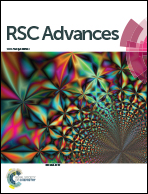Prospective application of Aspergillus species immobilized in sodium montmorillonite to remove toxic hexavalent chromium from wastewater
Abstract
An interdisciplinary approach involving chemistry and biotechnology offers greener solutions to mitigate heavy metal pollution originating from wastewaters. Aspergillus species (fungi) were isolated from bread and immobilized in sodium montmorillonite (an inorganic clay material). This biosorbent has good ability to remove toxic Cr(VI) from an acidic medium with a Langmuir adsorption capacity of 45.72 mg g−1. FTIR, SEM-EDAX, optical imaging and TGA techniques were used to explore the characteristics of the biosorbent before and after Cr(VI) adsorption. Optimum pH and temperature for Cr(VI) biosorption were 2.0 and 30 °C, respectively and the kinetics followed the pseudo second order model. The biosorbent regeneration was accomplished using sodium hydroxide. As a proof of concept, the method was validated in an industrial effluent wastewater sample of BCR-715, a certified reference material. The biosorbent can also be very useful to treat tannery and electroplating wastewaters discharging chromium.


 Please wait while we load your content...
Please wait while we load your content...